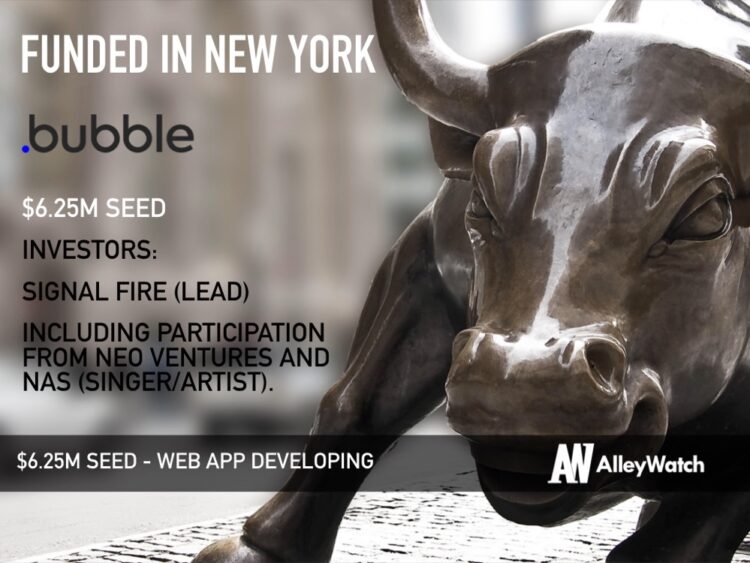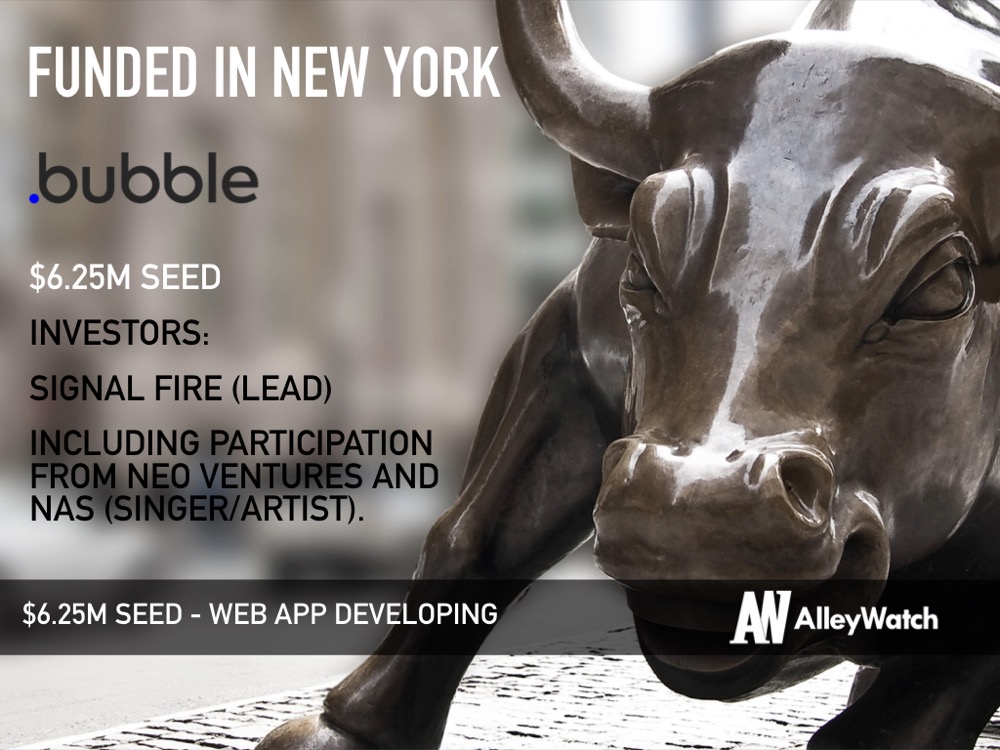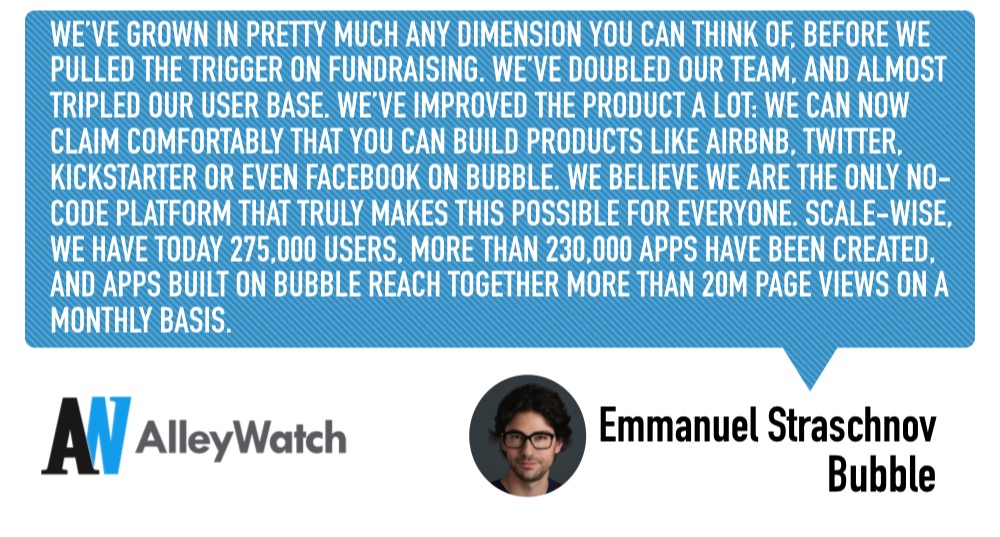Now you can design a fully functional web app without writing any code thanks to Bubble. Founded in 2012, the company’s visual programming language is empowering the masses by allowing people to build websites visually, all the way down to the pixel. Total mastery of Bubble takes just a few days and users build their web apps by using a series of UI element blocks. Anything you build on Bubble is completely customizable and there are some preset templates to get people started. While there are numerous platforms that serve as web builders, Bubble is the only one that allows you to build a complex, production-grade site for a variety of use cases. The platform promises that you can replicate the functionality of sites like Twitter or Airbnb with a few clicks. Best of all, this no code platform is completely free to use and strategically positioned to change the future of coding. Gone are the days of waiting for a developer to get your website done.
AlleyWatch caught up with founder Emmanuel Straschnov to learn more about the genesis of the business, its future plans, and latest round of funding.
Who were your investors and how much did you raise?
This is our first external investment ever, after 7 years as a profitable bootstrapped startup. SignalFire is leading this $6.25M seed round along with Neo Ventures, both of which are funds that represent impressive communities of entrepreneurs. It was important for us to also get the support of New York-based entrepreneurs, and we’re very excited that the founders of the New York startups Warby Parker, Harry’s, Flatiron Health, mParticle, and AdoreMe joined the round, along with the artist Nas, and New York investors Shana Fisher and David Fisher.
Tell us about the product or service that Bubble offers.
Bubble is a platform that enables people to build web apps without writing code. You build your product visually, UI element by UI element, and then you define what the application does by saying, for example, “when the user clicks on button ‘Pay’, charge the credit card, mark the order as paid, send an email and change the page”. You can define the user interface to the pixel and the sequence of actions action-by-action. There is no constraint, which enables you to have a very customized experience.
Most people use us to start companies, and they can do this without hiring engineers. In particular, non-technical people can use our tool to build their product without having to code. Once the product is built, we host everything on our cloud platform, so you don’t need to worry about maintaining servers, scaling your infrastructure, etc. In other words, on Bubble you focus on the product your users interact with, and we take care of the infrastructure. In terms of what you can build, Airbnb, Twitter, OkCupid are typical examples of what you can build on Bubble, without code.
 What inspired you to start Bubble?
What inspired you to start Bubble?
We started Bubble in 2012 because we felt that starting a company was just too costly in terms of engineering resources. Many projects, especially outside major cities, never even get off the ground. Our solution was to turn everyone into programmers: Bubble is a programming language designed to be learned in hours instead of months. This was a challenging problem: many projects promised code-free programming, but never to the point where people could build fully-functional products. To achieve this, we have invested almost seven years building Bubble and growing our community of entrepreneurs building on top of us.
How is Bubble different?
Bubble is very open-ended. That’s one thing that makes us different from a lot of, if not all, other no-code tools: you can build your designs to the pixel, and workflows action by action. While we have templates, many users decide to start without one. This means there is a learning curve – we estimate it to a few days – but once that you’ve learned the tool, you can build exactly what you need, without the hundreds of hours it would take you to learn how to code and build a production-ready platform.
What market does Bubble target and how big is it?
Currently, we target startups and small businesses considering building their solutions in-house or through outsourcing. Eventually, our goal is to define a new programming standard.
We want Bubble to become the by-default solution when someone needs to build a website, an app, etc. Therefore, our eventual market is the software industry as a whole, which is gigantic. I won’t try to give a number on this one…
We want Bubble to become the by-default solution when someone needs to build a website, an app, etc. Therefore, our eventual market is the software industry as a whole, which is gigantic.
What’s your business model?
Bubble is free to use, accessing the editor is totally free. As Bubble hosts all apps on its cloud platform, we charge on server usage. We follow a fairly traditional SaaS model. Users buy a plan with some given features for an app, and they can add capacity and storage as needed when their app scales. Bubble also has a marketplace where users can build and sell plugins, and we take a cut from these transactions.
How has the business changed since we last spoke in 2017?
We’ve grown in pretty much any dimension you can think of before we pulled the trigger on fundraising. We’ve doubled our team, and almost tripled our user base. We’ve improved the product tremendously: we can now claim comfortably that you can build products like Airbnb, Twitter, Kickstarter or even Facebook on Bubble. We believe we are the only no-code platform that truly makes this possible for everyone. Scale-wise, we have today 275,000 users, more than 230,000 apps have been created, and apps built on Bubble reach together more than 20M page views on a monthly basis.
What was the funding process like?
We started thinking about the process late November 2018 and started meeting with investors in early February 2019. We signed our term sheet early March, and close late March. We were quite lucky to have this process go that fast.
The process can be rough at times, but overall, it’s been quite enjoyable to meet with tech investors and get their perspective on Bubble. The team had been focused on the product and community for a few years, and we hadn’t met with investors and advisors for a very long time. Doing so helped us articulate our vision better and improve our strategy for the coming months.
What are the biggest challenges that you faced while raising capital?
It took us a few iterations to figure out how to explain our vision well. Bubble is a low-end disruption of software development, and this took us quite some time to illustrate clearly during a 45-minute pitch.
What factors about your business led your investors to write the check?
Some investors really bought into a future without code, some others had a harder time seeing this trend. The investors that gave us offers all saw this future as the natural evolution of where tech is going.
Some investors really bought into a future without code, some others had a harder time seeing this trend. The investors that gave us offers all saw this future as the natural evolution of where tech is going.
And SignalFire, in particular, was quite familiar with the product already, as quite a lot of their team members were using Bubble before we met them in person.
What are the milestones you plan to achieve in the next six months?
We want to become the primary platform for startup creation, first in New York and then beyond. Basically, whenever someone is thinking about a web-based startup, we want him or her to start with Bubble to build and launch his product. We have a lot of room to grow in New York, the new few months are quite exciting.
What advice can you offer companies in New York that do not have a fresh injection of capital in the bank?
Before raising money, I think it is really important to build a product that people love. And with the lowering cost of technology (and here Bubble helps a lot!), you can do a lot without external funding.
What’s your favorite restaurant in the city?
I’m a fan of Sichuan food, and Szechuan Mountain House is the best one in town I think.





